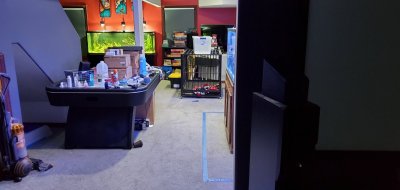- Joined
- Dec 6, 2019
- Messages
- 218
- Reaction score
- 244
I am in the planning stages of a 96x36x30 plywood tank, and am struggling to decide on how I'd like the overflows. Almost every plywood build I've seen uses some sort of external overflow across the back of the tank.
Due to where I'm placing the tank, 36" is allllllmost too wide, so the extra 3-4" I would need the tank moved out for plumbing just isn't going to work behind the tank. I know I also have the option of doing the plumbing down the sides of the tank, but both sides will be visible, so I really just don't want to.
Realistically, I'd like to do a corner overflow, drilled through the bottom of the tank, but I have not seen it done and would rather not try something that can't be accomplished properly...
I've found a vendor on eBay that sells acrylic corner overflows, that are customizable in size. I figured I could have them made in the appropriate height, and silicone them in, just like a traditional overflow. This brings up a few questions, however, that I feel might need addressed on such a tall tank.
I will be using pond armor, so I won't have any issues with adhesion on the silicone.
Is there a specific thickness of acrylic needed so it won't bow / bend / break with all the water pressure against it? Or will having water in the overflow push against the opposite side and make that a non-issue?
What size should the overflows be? I'd like to be able to flow 1400+ GPH through the tank, if needed, and I haven't yet decided on plumbing sizes.. I'd imagine 2" drains would be about right?
Is there something I'm missing here? What other options might I have? Will this work? I'd really like to avoid making the tank smaller, I'm already somewhat regretting going with 30" height over 24~, but if I have to drop the width down to 30", I drop below 400g and that will just make me sad....
Thanks for your help!
Due to where I'm placing the tank, 36" is allllllmost too wide, so the extra 3-4" I would need the tank moved out for plumbing just isn't going to work behind the tank. I know I also have the option of doing the plumbing down the sides of the tank, but both sides will be visible, so I really just don't want to.
Realistically, I'd like to do a corner overflow, drilled through the bottom of the tank, but I have not seen it done and would rather not try something that can't be accomplished properly...
I've found a vendor on eBay that sells acrylic corner overflows, that are customizable in size. I figured I could have them made in the appropriate height, and silicone them in, just like a traditional overflow. This brings up a few questions, however, that I feel might need addressed on such a tall tank.
I will be using pond armor, so I won't have any issues with adhesion on the silicone.
Is there a specific thickness of acrylic needed so it won't bow / bend / break with all the water pressure against it? Or will having water in the overflow push against the opposite side and make that a non-issue?
What size should the overflows be? I'd like to be able to flow 1400+ GPH through the tank, if needed, and I haven't yet decided on plumbing sizes.. I'd imagine 2" drains would be about right?
Is there something I'm missing here? What other options might I have? Will this work? I'd really like to avoid making the tank smaller, I'm already somewhat regretting going with 30" height over 24~, but if I have to drop the width down to 30", I drop below 400g and that will just make me sad....
Thanks for your help!
















